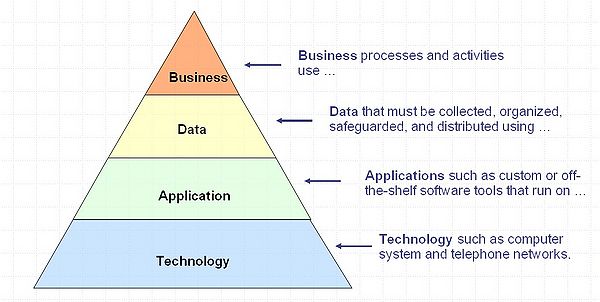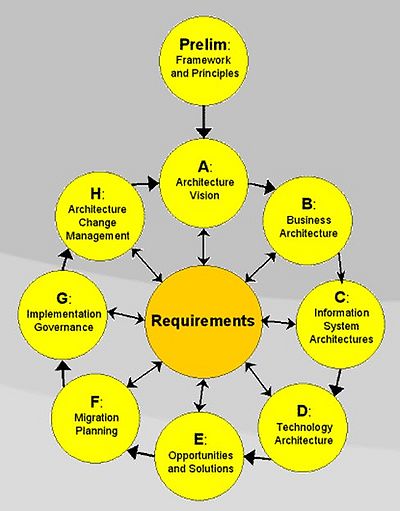Enterprise architecture framework: Difference between revisions
m (→Links) |
m (→Links) |
||
| Line 42: | Line 42: | ||
* [http://en.wikipedia.org/wiki/Enterprise_architecture Enterprise architecture] | * [http://en.wikipedia.org/wiki/Enterprise_architecture Enterprise architecture] | ||
* [http://en.wikipedia.org/wiki/Enterprise_architecture_framework enterprise architecture framework] | * [http://en.wikipedia.org/wiki/Enterprise_architecture_framework enterprise architecture framework] | ||
* [http://en.wikipedia.org/wiki/Enterprise_modeling | * [http://en.wikipedia.org/wiki/Enterprise_modeling Enterprise modeling], the abstract representation, description and definition of the structure, processes, information and resources of an identifiable business, government body, or other large organization. | ||
* [http://en.wikipedia.org/wiki/Business_process Business processes] | * [http://en.wikipedia.org/wiki/Business_process Business processes] | ||
* [http://en.wikipedia.org/wiki/Business_architecture | * [http://en.wikipedia.org/wiki/Business_process_modeling Business process modeling], the activity of representing processes of an enterprise, so that the current process may be analyzed and improved. See also [[BPMN]]. | ||
* [http://en.wikipedia.org/wiki/Process_architecture | * [http://en.wikipedia.org/wiki/Business_architecture Business architecture] | ||
* [http://en.wikipedia.org/wiki/Process_architecture Process architecture] | |||
* [http://en.wikipedia.org/wiki/Operating_Model Operating Model] | * [http://en.wikipedia.org/wiki/Operating_Model Operating Model] | ||
* [http://en.wikipedia.org/wiki/Architecture_domain architecture domains] | * [http://en.wikipedia.org/wiki/Architecture_domain architecture domains] | ||
* [http://en.wikipedia.org/wiki/TOGAF TOGAF] | * [http://en.wikipedia.org/wiki/TOGAF TOGAF] | ||
* [http://en.wikipedia.org/wiki/Open_Source_Enterprise_Architecture_Tools Open Source Enterprise Architecture Tools] | * [http://en.wikipedia.org/wiki/Open_Source_Enterprise_Architecture_Tools Open Source Enterprise Architecture Tools] | ||
* | |||
; Introductions | ; Introductions | ||
| Line 56: | Line 58: | ||
[[Category: workflow]] | [[Category: workflow]] | ||
[[Category: Organization and management]] | [[Category: Organization and management]] | ||
[[Category: | [[Category: Affect and motivation]] | ||
Revision as of 18:57, 23 June 2010
Introduction
An enterprise architecture (EA) framework is a "language" that allows to describe the architecture of organizations.
Wikipedia (retrieved June 22, 2010) describes “An enterprise architecture (EA) [as] a rigorous description of the structure of an enterprise, its decomposition into subsystems, the relationships between the subsystems, the relationships with the external environment, the terminology to use, and the guiding principles for the design and evolution of an enterprise.[1][2][3] This description is comprehensive, including enterprise goals, business functions, business process, roles, organisational structures, business information, software applications and computer systems. [...] Enterprise architects use various business methods, analytical techniques and conceptual tools to understand and document the structure and dynamics of an enterprise. In doing so, they produce lists, drawings, documents and models, together called "artifacts". These artifacts describe the logical organization of business functions, business capabilities, business processes, people organization, information resources, business systems, software applications, computing capabilities, information exchange and communications infrastructure within the enterprise.”
See also: workflow, change management and process notation/execution languages like BPEL and BPMN
Examples of EA frameworks
The Open Group Architecture Framework
According to Wikipedia, The Open Group Architecture Framework (TOGAF) is based on four pillars, called domains:
- architecture or business process architecture which defines the business strategy, governance, organization, and key business processes of the organization
- architecture which provides a blueprint for the individual application systems to be deployed, the interactions between the application systems, and their relationships to the core business processes of the organization with the frameworks for services to be exposed as business functions for integration.
- architecture which describes the structure of an organization's logical and physical data assets and the associated data management resources
- architecture or technology architecture which describes the hardware, software and network infrastructure needed to support the deployment of core, mission-critical applications. (retrieved 16:59, 23 June 2010 (UTC))

An interesting TOGAF topic concerns architecture development including change management:

The Zachman frameworks
“The Zachman Framework is an Enterprise Architecture framework for enterprise architecture, which provides a formal and highly structured way of viewing and defining an enterprise. It consists of a two dimensional classification matrix based on the intersection of six communication questions (What, Where, When, Why, Who and How) with six rows according to reification transformations.” (Wikipedia, retrieved 17:08, 23 June 2010 (UTC)).

Business motivation model
The Business Motivation Model (BMM) developed by Object Management Group defines the what, why and how for an organization. In more operational terms it defines the ends, the means, influences (pro/against) and assessments.
Links
- Some Wikipedia links
- Enterprise architecture
- enterprise architecture framework
- Enterprise modeling, the abstract representation, description and definition of the structure, processes, information and resources of an identifiable business, government body, or other large organization.
- Business processes
- Business process modeling, the activity of representing processes of an enterprise, so that the current process may be analyzed and improved. See also BPMN.
- Business architecture
- Process architecture
- Operating Model
- architecture domains
- TOGAF
- Open Source Enterprise Architecture Tools
- Introductions
- Niles E Hewlett (2006), The USDA Enterprise Architecture Program. PMP CEA, Enterprise Architecture Team, USDA-OCIO. January 25, 2006. PPT